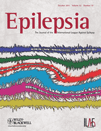The effect of age and comedication on lamotrigine clearance, tolerability, and efficacy
Summary
Purpose: To compare pharmacokinetics, tolerability, and efficacy of lamotrigine (LTG) in older versus younger adults.
Methods: We studied 686 adult outpatients seen at our center over 5 years. We compared apparent clearance (CL) of LTG in the youngest (16–36 years; n = 247) and oldest (55–92 years; n = 155) tertiles. We analyzed one-year retention for younger and older adults newly started on LTG, frequency of adverse effects causing intolerability, and rates of specific adverse effects. We also investigated 6-month seizure freedom.
Key Findings: Median LTG CL of older adults taking LTG in monotherapy was approximately 22% lower compared to younger adults (28.8 vs. 36.5 ml/h/kg; p < 0.001). LTG CL in older adults was lower compared to younger adults in patients on polytherapy and on polytherapy without enzyme inducers or valproate. One-year retention for LTG was comparable in older (78.1%, 121/155) and younger (72.4%, 179/247) adults. Intolerability to LTG was higher in older (34.8%) versus younger adults (24.2%; p = 0.005). Imbalance, drowsiness, and dizziness were common intolerable side effects in both groups. Older patients had higher rates of intolerability due to imbalance (16% vs. 4%), drowsiness (13% vs. 7%), and tremor (5% vs. 2%) compared with younger patients. Rates of 6-month seizure freedom were comparable, and small numbers of each group benefited from very high levels of LTG (>15 μg/ml).
Significance: LTG CL in monotherapy in older adults is approximately 20% lower than in younger adults. For a given serum LTG level, older adults are twice as likely to have significant adverse effects compared to younger adults. Older patients are more likely to experience imbalance, drowsiness, and tremor than younger patients. Younger adults tolerate LTG better than older adults, but one-year retention is comparable. Some patients may benefit from high serum levels of LTG.




